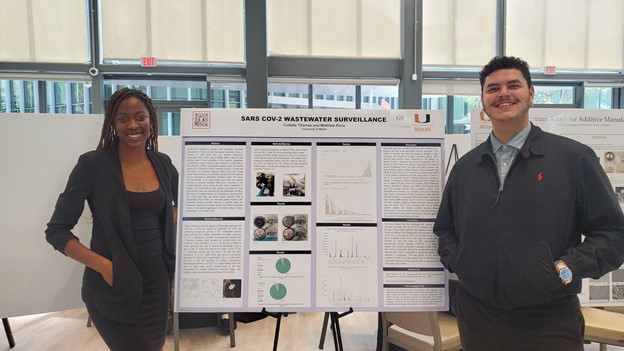RADx-UP Program Receives NIH Supplement for COVID Detection in Wastewater
By: Joey Garcia | May 18, 2022
In an innovative effort to study COVID-19 virus particles in the wastewater of Miami-Dade County schools, the National Institutes of Health (NIH) has awarded a $635,000 supplement to the Rapid Acceleration of Diagnostics for Underserved Populations (RADx-UP) program at the University of Miami Miller School of Medicine — in addition to the program’s existing $3 million grant.
Led by Lisa Gwynn, D.O., M.B.A., M.S.P.H., associate professor of clinical pediatrics and public health sciences, the Miller School’s RADx-UP program studies the feasibility of COVID-19 testing and vaccination campaigns in the school setting, focusing on underserved and vulnerable populations that are subject to disparities in COVID-19 morbidity and mortality.
The program has developed testing methods and technologies focusing on the nine school-based clinics in the county that are part of UM’s Dr. John T. Macdonald Foundation School Health Initiative (SHI), which includes four elementary schools, two middle schools, and three high schools.
RADx Connections
The University of Miami College of Engineering, along with the Miller School and Sylvester Comprehensive Cancer Center, conduct a similar RADx wastewater program, known as RADx-rad. Helena Solo-Gabriele, Ph.D., environmental engineering professor; Stephan Schürer, Ph.D., professor of pharmacology at the Miller School; and George Grills, Sylvester’s director of shared resources serve as PIs for the program.
The RADx-rad project focuses on the quantification of viral particles in sewage wastewater. By collaborating with RADx-UP, both programs have greater opportunities to use wastewater discoveries for COVID-19 detection.
“The RADx-rad team reached out to me to collaborate, as we are both RADx programs,” said Dr. Gwynn, who is also the medical director for the Pediatric Mobile Clinic and program director for the SHI. “We decided to work together on a leveraged pilot study from January to March, to look at COVID viral particles in the wastewater of the schools involved in our RADx-UP study. This work caught the NIH’s interest and they granted the additional funding.”
“The health data available through the RADx-UP project is the perfect complement to the wastewater data from the RADx-rad project, which will allow for establishing wastewater as a way of predicting the health of the school populations,” Dr. Solo-Gabriele said.
Collaborations in Action
With the supplemental funding, the University’s schools and colleges and the school district will work together to track potential surges in COVID-19.
Detecting virus-particle surges in the wastewater is a complex process involving the innovative uses of dyes. First, engineers from the school district and the University had to identify appropriate wastewater sampling sites for the schools.
With the testing areas mapped out, the sampling devices are dropped into the sampling sites: manholes and wastewater lift stations. Samples are then sent to the Sylvester Comprehensive Cancer Center Biospecimen Shared Resource and Oncogenomics Shared Resource, the Center for AIDS Research, and the genomics laboratory at Weill Cornell Medicine, where they are processed to determine levels of the COVID-19 virus and the presence of variants through sequencing analyses.
“To analyze the RNA of the COVID-19 virus in wastewater is a technological and data processing challenge which requires the collaboration of several laboratories and a large team of individuals with different expertise, ranging from public health, engineering, molecular science, and data science to epidemiology,” Dr. Solo-Gabriele said.
Dr. Gwynn and the RADx-UP and RADx-rad teams will meet with the district every week to review data from the sampled wastewater. Ultimately, the plan is to develop a course of action depending upon the levels observed in the wastewater.
“Since people aren’t testing as frequently for COVID-19, this is an opportunity for us to stay ahead of the game,” Dr. Gwynn said. “This study will allow us to catch surges before they escalate and be ready with appropriate public health mitigation strategies.”
Future Innovations
Even during times when wastewater data do not indicate immediate action, RADx-UP and RADx-rad teams continue to have conversations with Miami-Dade County Public Schools to better prepare in the event of another spike in cases. Possible scenarios for handling those situations, such as ramping up testing in a specific school, aggressive contact tracing, and quarantine, are being fined-tuned as the program gains experience.
The RADx-UP team hopes not only to serve the current nine schools, but to take the pilot program and apply it to the entire school district. They also wish to expand the project to implement testing for other respiratory diseases.
“This is a beautiful collaboration between engineering, environmental health, and clinical pediatrics,” Dr. Gwynn said. “This combination brings all our talents together to make the right decisions for the school district, with the ultimate goal of keeping kids safe in school.”




